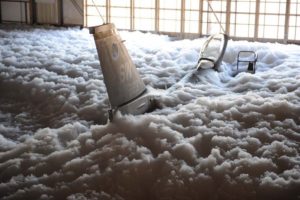High PFAS toxin levels found in Starkweather Creek sediment [by Truax Field ANG base]
The Cap Times | 24 April 2020 | Steven Elbow

Starkweather Creek Watershed Map
“Test results of PFAS in troubled Starkweather Creek sediment show high levels for one of the more toxic varieties of the chemical group.
[per- and polyfluoroalkyl substances]
The results add to concerns about PFAS pollution in the creek, where water, foam and fish have already been found to have high levels of the man-made chemicals that are linked to an array of health problems, including immune deficiencies, liver and kidney problems, birth defects and cancer.

The tests were commissioned by the Midwest Environmental Justice Organization (MEJO), which sent samples from five sites along the creek to the state Lab of Hygiene last fall.
Maria Powell, director of the group, said she arranged for the testing after her requests were rejected by the city and county officials, and by the state Department of Natural Resources, which has conducted similar tests that found contamination in the creek.
“Sediment PFAS data is critical for understanding how PFAS compounds travel through aquatic food webs and for comprehensively assessing ecological risks to the creek, lake, fish, birds and wildlife,” she said.
She said the current coronavirus pandemic adds to the dangers posed by PFAS contamination and called for remediation of the sediment.
“The COVID-19 crisis further highlights the need to clean up PFAS and other toxic chemical pollution,” she said. “PFAS exposures are associated with immune system deficiencies that make people more likely to become infected by diseases such as COVID-19 and more likely to die from them.”

While there are no standards for PFAS contamination in Wisconsin, the state Department of Health Services has recommended a combined groundwater limit of 20 parts per trillion (ppt) for two of the oldest and most toxic PFAS variants, PFOS and PFOA. The U.S. Environmental Protection Agency recommends a limit of 70 parts per trillion.
The most prevalent chemical found in the creek’s water, fish and sediment is PFOS, an ingredient in firefighting foam once used routinely by the Air National Guard at Truax Field, which is upstream of the Starkweather Creek contamination.
In January, the state issued advisories to limit the consumption of fish caught in the creek after testing revealed up to 110,000 ppt in fish tissue. In December, foam near the creek’s boat launch at Olbrich Park showed levels of up to 92,000 ppt. And in October, water from the creek had concentrations of up to 270 ppt.
Powell said that the sediment findings are important because fish take up PFAS from the sediment, then are consumed by anglers and their families.

“Many shoreline anglers here in Madison are low-income people of color who depend on this fish as a source of food,” she said, “so they are disproportionately at risk for these health problems.”
The highest level of PFOS in sediment was found in a sample taken just downstream of the Bridges Golf Club ditch, near the former Burke sewage treatment plant. That sample had 21,400 ppt of PFOS, and 24,482 ppt for total PFAS. A sample from the creek at Anderson Street registered 17,900 ppt for PFOS, and 27,800 ppt for total PFAS. A sample at Olbrich Park had 7,260 ppt for PFOS and 8,190 ppt total PFAS. And a sample from the creek at Fair Oaks Avenue registered 2,020 ppt for PFOS, with no other PFAS present.
By comparison, a tributary that is not downstream from Truax Field showed 392 ppt for PFOS and 643 ppt for total PFAS.

The growing awareness of PFAS, which are found in nearly all humans, has raised concerns of a looming public health crisis. High illness rates have been found in populations near factories that manufacture the chemicals and airports and military operations where they were used. The chemicals, called “forever chemicals” because they don’t break down in nature, have permeated water reservoirs across the U.S., and at least trace amounts have been detected in the vast majority of drinking water samples recently tested by the Environmental Working Group.
So-called “long-chain” PFAS, most commonly PFOA and PFOS, are considered the most toxic and were widely unleashed on the environment in the manufacture of products like Teflon and Scotchgard. Those compounds are no longer produced in the U.S., but thousands of replacements, which industry groups claim are safer, also pose risks. Those chemicals are used in a vast array of consumer goods and industrial applications.
In Wisconsin, the worst known PFAS contamination is in Marinette and neighboring Peshtigo, where Peshtigo-based Tyco Fire Products had tested firefighting foam for decades, and where a PFAS plum has contaminated wells and streams.
Last year, after the election of Democratic Gov. Tony Evers, the state embarked on a campaign to increase testing and regulation of the chemicals.

In Madison, contamination at Dane County Airport and adjoining Truax Field, where high levels have been detected, has set off a round of finger pointing that has pitted the city and the county against the Air National Guard. While the guard has pledged to take the necessary steps to deal with the contamination, many suspected hot spots have yet to be tested.
Heightening tensions is the announcement that Truax will host a squadron of F-35 fighter jets, which will entail extensive construction at the airfield. Critics say that construction will disrupt soil and groundwater, which will spill yet more contamination into Starkweather Creek.”
- Steven Elbow
Background
- Friends of Starkweather Creek : a volunteer organization of citizen stewards, advocates, explorers and educators seeking to serve and honor both people and place in soul-serving synergy (with all stakeholders… in and out of the watershed).
- Starkweather Environmental Justice Project : engaging people living in the Truax and Darbo Worthington neighborhoods in learning about Starkweather Creek and about how a variety of storm-water pollution issues affect the creek.
- PFAS and Truax – Tom Boswell 1
- Forever Wars & Forever Pollutants
- PFAS and Water Contamination with Pat Elder and Rebecca Kemble
- The Military is Poisoning America’s Ground Water – Pat Elder
- THE PENTAGON’S 50-YEAR HISTORY WITH PFAS CHEMICALS
- 3M KNEW ABOUT THE DANGERS OF PFOA AND PFOS DECADES AGO, INTERNAL DOCUMENTS SHOW
